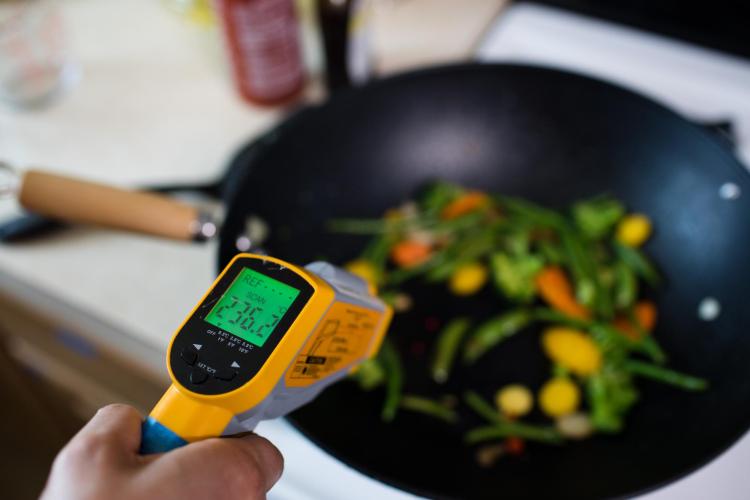CU and CSU professors work together to study indoor air quality

Humans spend about 90 percent of our lives inside, so it’s time we analyzed what we’re breathing while we’re there.
“There has been a huge gap between the research done indoors and out,” said Marina Vance, a professor in the mechanical engineering department. “When you think of the news and studies on air quality, people are always studying the outdoors.”
Vance spent June leading the largest collaborative study to date on indoor air quality at a research house at the University of Texas, Austin research campus. She called it HOMEChem.
“Most of the studies done on indoor air quality have been on occupational safety and comfort, measuring for individual compounds known to be detrimental to human health,” she said. “Meanwhile, outdoor studies look at the air’s chemistry and interactions. We wanted to learn from that and bring a more holistic approach to studying indoor air quality.”
The Sloan Foundation funded the study as part of an initiative to understand the chemical processes happening in indoor environments. Working with Delphine Farmer, a professor of chemistry at Colorado State University, Vance developed a collaboration that would incorporate Farmer’s goal of data-sharing on the topic and Vance’s goal of community- building. The collaboration ended up with 20 faculty members from 13 universities.
“In order to not focus on individual compounds, we had to measure many things at once,” Vance said.
While some studies are done with offline samples, like a cup of water taken from a river that gives a snapshot of the river at that specific point in time, the HOMEChem study was online, with measurements taken in real-time without pause. The researchers outfitted the house, a pre- manufactured 1,200-square-foot home with three bedrooms and two bathrooms, with varying instrumentation. With some windows converted to sampling ports and holes drilled in the walls for cables and tubing, the team led sampling lines to the house from four trailers full of instruments.
Vance and her team performed activities representative of those people do in their homes, like cooking, cleaning and occupying. The latter included the use of personal care products, many of which they found put out unhealthy compounds.
“There are so many preconceived notions of what a clean home is,” Vance said. “I love that quote, ‘That smells fresh.’ You put an air freshener in the wall that smells like flowers, and you’re putting air pollution in your house. The same is true for scented candles and perfumes.”
Of the three kinds of cleaners they used, the chlorine-based was the most problematic.
“Chlorine is very reactive,” Vance said. “The chemical compounds it released created new compounds, including chloramines which can cause respiratory irritation.”
For cooking, the team mimicked typical days and also atypical ones. The team had Thanksgiving, in June, in Texas, twice.
“I went to see a man about a turkey,” Vance said about the dinners. “It’s surprisingly difficult to find a whole raw turkey in June.”
Four volunteers cooked a Thanksgiving dinner before twelve guests arrived and ate the meal with the windows and doors closed, as on Thanksgiving it is often cold and the emissions are withheld.
“We had a very delicious, complete Thanksgiving meal,” Vance said. “And we had very unhealthy levels of air pollution inside the house, the highest we measured during the study.”
Did it scare those present?
“It did,” Vance said. “But we were expecting it. And we’re all scientists, so we were actually happy. It’s crazy the things we’ll do in the name of science.”
The emissions came mostly from roasting the turkey and vegetables in the oven.
“It’s really the temperature,” Vance said. “It didn’t matter so much what we cooked as how hot we cooked it. The key recommendation is: Use your range hood every time you cook. If you have a gas stove, use it even if you’re just boiling water.”
The scariest part of the study, in Vance’s opinion, was the observation of semivolatile organic compounds, or SVOCs. These sit on surfaces until disturbed and then they take to the air, latching onto dust and finding their way into our lungs. One example of an SVOC is the plasticizer on vinyl flooring.
“Research is finally getting to the point of analyzing SVOCs in real time, which are very important to human health,” Vance said. “Dust particles can act as a Trojan horse because they can travel deep into your lungs and release those SVOCs there.”
Vance emphasized that HOMEChem is at the start of indoor air chemistry field studies, with many more necessary to discover how to optimize our health within our homes. “This has been the most comprehensive indoor air chemistry study in a home environment,” she said. “But we cannot answer every question, no way. We’re just discovering new ones.”

